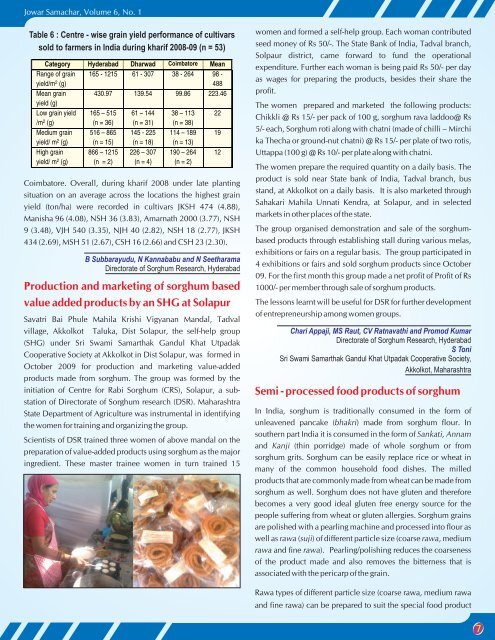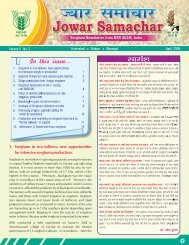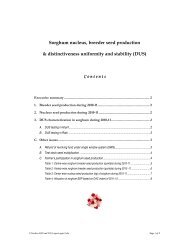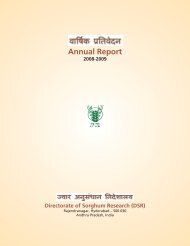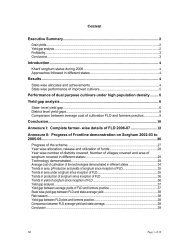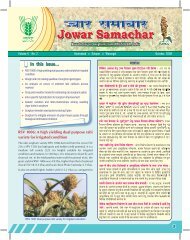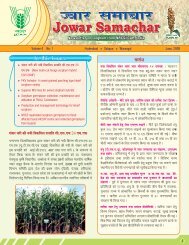jowar samachar feb 2010 - Directorate of Sorghum Research
jowar samachar feb 2010 - Directorate of Sorghum Research
jowar samachar feb 2010 - Directorate of Sorghum Research
You also want an ePaper? Increase the reach of your titles
YUMPU automatically turns print PDFs into web optimized ePapers that Google loves.
Jowar Samachar, Volume 6, No. 1<br />
Table 6 : Centre - wise grain yield performance <strong>of</strong> cultivars<br />
sold to farmers in India during kharif 2008-09 (n = 53)<br />
Category Hyderabad Dharwad Coimbatore Mean<br />
Range <strong>of</strong> grain<br />
yield/m2 165 - 1215 61 - 307 38 - 264 98 -<br />
(g)<br />
488<br />
Mean grain<br />
yield (g)<br />
430.97 139.54 99.86 223.46<br />
Low grain yield<br />
/m2 165 – 515 61 – 144 38 – 113 22<br />
(g)<br />
(n = 36) (n = 31) (n = 38)<br />
Medium grain<br />
yield/ m2 516 – 865 145 - 225 114 – 189 19<br />
(g) (n = 15) (n = 18) (n = 13)<br />
High grain<br />
yield/ m2 866 – 1215 226 – 307 190 – 264 12<br />
(g) (n = 2) (n = 4) (n = 2)<br />
Semi - processed food products <strong>of</strong> sorghum<br />
In India, sorghum is traditionally consumed in the form <strong>of</strong><br />
unleavened pancake (bhakri) made from sorghum flour. In<br />
southern part India it is consumed in the form <strong>of</strong> Sankati, Annam<br />
and Kanji (thin porridge) made <strong>of</strong> whole sorghum or from<br />
sorghum grits. <strong>Sorghum</strong> can be easily replace rice or wheat in<br />
many <strong>of</strong> the common household food dishes. The milled<br />
products that are commonly made from wheat can be made from<br />
sorghum as well. <strong>Sorghum</strong> does not have gluten and therefore<br />
becomes a very good ideal gluten free energy source for the<br />
people suffering from wheat or gluten allergies. <strong>Sorghum</strong> grains<br />
are polished with a pearling machine and processed into flour as<br />
well as rawa (suji) <strong>of</strong> different particle size (coarse rawa, medium<br />
rawa and fine rawa). Pearling/polishing reduces the coarseness<br />
<strong>of</strong> the product made and also removes the bitterness that is<br />
associated with the pericarp <strong>of</strong> the grain.<br />
Rawa types <strong>of</strong> different particle size (coarse rawa, medium rawa<br />
and fine rawa) can be prepared to suit the special food product<br />
7


